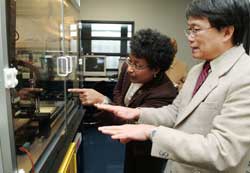Genomics attracts political attention

Adrian Tsang believes that everything should be recycled, and enzymes are key. Here he shows MP Marlene Jennings some of the sophisticated equipment used in genomics research at Concordia.
photo by Kate Hutchinson
As part of a “Genomics on the Hill” event held Nov. 7 in Ottawa, researchers representing seven teams from across Canada spent a day talking to members who dropped in on their way to and from sessions in the House.
At one of those sessions, Adrian Tsang met Marlene Jennings, the MP for the riding that includes the Loyola Campus. He invited her to visit the Centre for Structural and Functional Genomics, of which he is the director.
“Ms. Jennings was surprised to see that one of the seven teams invited to Parliament Hill, and the only Quebec team, was from her riding,” Tsang said. “She came to find out more about our work and how she can further promote science research and postsecondary education. “The Centre got off to a great start in 1999 with more than $3 million from the Canada Foundation for Innovation and another $1 million from industry. The funds enabled Concordia to build a core genomics facility that takes up much of the fifth floor of the Richard Renaud Science Complex. At its height, the Centre kept about 40 researchers and technicians busy.
Genomics and bioinformatics have revolutionized the way the pharmaceutical, agricultural and other biotech industries do research and development. This is exciting multidisciplinary work that draws on the skills of biochemists, neurobiologists, microbiologists, chemists, bioengineers and computer scientists.
Much of their work focuses on enzymes. Enzymes can be put to many uses, such as breaking down wood and removing fat and protein from clothes. There are applications in the food, pulp and paper, and forestry industries, just to name a few. For example, they can replace or supplement the chemicals now used as pulp bleaching agents. In one of the research projects, 70,000 new genes are being studied from 15 fungal species.
When Jennings visited the CFSG lab, she was shown some of the equipment the researchers use. This includes a colony picker robot that can pick thousands of colonies a day from solid agar plates and transfer them to a liquid medium for growth and further processing. (Each colony is the source of a single gene.)
Then there’s a microarrayer, a robot that can deposit up to 80,000 spots of DNA, each corresponding to a single gene, on a standard 7.5 cm x 2.5 cm glass slide and print up to 75 slides at once. The slides are then used to compare two sets of cells grown under different conditions (for example, the presence or absence of a toxin) to see which of the 80,000 genes are turned on, which are turned off, and which stay the same under the two different conditions.
Microarray readers provide an image of the microarray (imagine trying to see 80,000 spots on a 7.5 cm x 2.5 cm slide by eye!) that is further analyzed by powerful computer software.
The Centre has supported many different research projects; the two largest were funded by Genome Canada and Genome Quebec to a total of about $10 million.
Recently, a Canada Foundation for Innovation application to fund upgrades and additional equipment for the Centre was turned down. Tsang and the researchers who work with him expect to hear why this month, and they discussed the matter with Jennings, who is an old hand on Parliament Hill.
“We were very impressed,” said Justin Powlowski, a biochemist and Associate Dean, Facilities, for Arts and Science. “It was useful to learn about her connections with the various funding bodies and programs that we deal with, and it provided us with the chance to provide feedback to her about what we thought worked (or didn’t work).”
When the biggest projects ended in 2004 and 2005, “we had to let go of some very good people,” Powlowski said. “However, the Centre has always been open to all researchers at Concordia.”
Full-time manager Peter Ulycznyj and full-time biotechnologist Marc Champagne help people with the equipment and provide expertise. “Their positions are funded by the Faculty of Arts and Science and the university, so they have been there through the dip in funding that we have been through recently,” Powlowski said.
All the members on the Centre’s website are still active, Powlowski said, because they have individual research grants that provide funds for students, and they use the Centre for those projects.
“Industry continues to help by collaborating on research grant applications, mostly by contributing expertise and services. In some cases, our graduate students do some of their work in our industrial collaborators’ labs. Quite a few funding programs now require industrial partners to come up with a certain level of co-funding, and we have never had a problem finding them.”
Tsang said he’s optimistic that the Centre will regain major funding from government and industry, and soon. “Last month the Centre received three grants totalling about $1.5 million,” he said. “We also have other major proposals that have received initial approval.
“Compared with other researchers in the country, we are doing quite well. We always want more to expand our research and graduate training capacity. In many ways, we should be grateful for what we manage to do with the federal support.”